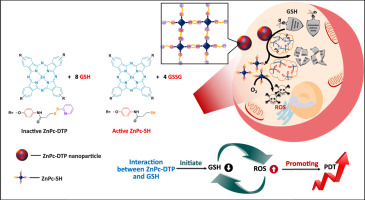周林副教授和魏少华教授课题组在FREE RADICAL BIOLOGY AND MEDICINE发表研究论文
Pre-drug Self-assembled Nanoparticles: Recovering activity and overcoming glutathione-associated cell antioxidant resistance against photodynamic therapy
Xu, KK (Xu, Kaikai)[ 1 ] ; Yao, H (Yao, Hai)[ 1 ] ; Hu, JH (Hu, Jinhui)[ 1 ] ; Zhou, JH (Zhou, Jiahong)[ 1 ] ; Zhou, L (Zhou, Lin)[ 1 ] *(周林); Wei, SH (Wei, Shaohua)[ 1 ]*(魏少华)
[ 1 ] Nanjing Normal Univ, Jiangsu Collaborat Innovat Ctr Biomed Funct Mat, Jiangsu Key Lab Biofunct Mat, Coll Chem & Mat Sci,Key Lab Appl Photochem, Nanjing 210023, Jiangsu, Peoples R China
FREE RADICAL BIOLOGY AND MEDICINE,201808,124,431-446
In photodynamic therapy (PDT), the elevated glutathione (GSH) of cancer cells have two sides for treatment efficacy, activation pre-drug by removing activity suppressor part (advantages) and consumption reactive oxygen species (ROS) to confer PDT resistance (disadvantages). Preparation all-in-one system by simple method to make best use of the advantages and bypass the disadvantages still were remains a technical challenge. Herein, we report a robust PDT nanoparticle with above function based on a self-assembled pyridine modified Zinc phthalocyanine (ZnPc-DTP). The activity suppressor and active part of ZnPc-DTP were linked by disulfide bond. After targeting cancer cells, GSH can react with ZnPc-DTP nanoparticles by cutting disulfide bond to release its active part (ZnPc-SH) and oxidize GSH. In vitro and in vivo results indicated that ZnPc-SH can effective suppress tumor growth under the low antioxidant tumor microenvironment (TME).

文章链接:
https://www.sciencedirect.com/science/article/pii/S0891584918311377?via%3Dihub
版权与免责声明:本网页的内容由收集互联网上公开发布的信息整理获得。目的在于传递信息及分享,并不意味着赞同其观点或证实其真实性,也不构成其他建议。仅提供交流平台,不为其版权负责。如涉及侵权,请联系我们及时修改或删除。邮箱:sales@allpeptide.com